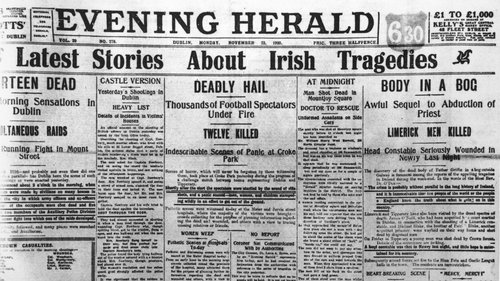
[dropcap]L[/dropcap]ast week RTÉ broadcast a documentary, Bloody Sunday 1920, commemorating the 100-year anniversary of the tragedy. And it was lovely.
Director Keith Walsh walks us, quite literally, through the streets of Dublin through the events of that day. Parallels were drawn with the past and present, seamlessly stitching that day 100 years ago to November 21, 2020.
As narrators spoke of people walking to Croke Park on that day, the documentary showed us the all too familiar sites of crowds marching towards the stadium, flooding the streets with their county colours. Empty streets of Dublin City when describing the curfew enforced, the ominous silhouette of Dublin Castle when the topic of British rule came up, all linking two periods in time a century apart.
All of this was reinforced by extensive access to archived footage of Croke Park, IRA members of the time and the War of Independence.
The dark, ominous music perforated the entire programme, setting a tone of dread and apprehension and accelerating in the moments of conflict.
In classic RTÉ fashion, the programme was well structured, blatantly so. Part One was what happened the morning of November 21, 1920 – the assassination of the British by Michael Collin’s Squad.
Part Two saw the lead up to the match, the moves of British forces and the executions carried out. Part Three showed the aftermath, the effects of Bloody Sunday on the Irish masses, on the British and, most pointedly, the victims.
This documentary was no republican, patriotic tribute to the IRA or the freedoms fighters of the War of Independence, or an attack piece on the Black and Tans, the Auxiliaries and the British. Bloody Sunday 1920 was fuelled by the human stories of the survivors and victims of that day.
Relatives of those who were killed that day propelled the documentary’s storyline. That – paired with the expert insight and explanations from professors and lecturers from UCD, DCU Trinity and Laurentian University in Canada – gave an extensive overview of what happened that day and how it impacted the people of Ireland then and now.
The documentary was either filmed before March of this year or only used footage from before then, as there wasn’t a mask in sight. I think that brought an even bigger sense of comfort and nostalgia to the programme, reminding us of the times where we would pour into Croker, not caring who we touched or breathed on.
The documentary was a depiction of sheer Irishness and handled the ever-controversial task of the fight for independence tastefully and focussing on all impacts and Aspects of Bloody Sunday, November 21, 1920. 4/5 stars.
Niamh Quinlan
Image Credit: RTÉ
Note: This article was reuploaded on 24/03/2021 due to a fault with The College View website.



